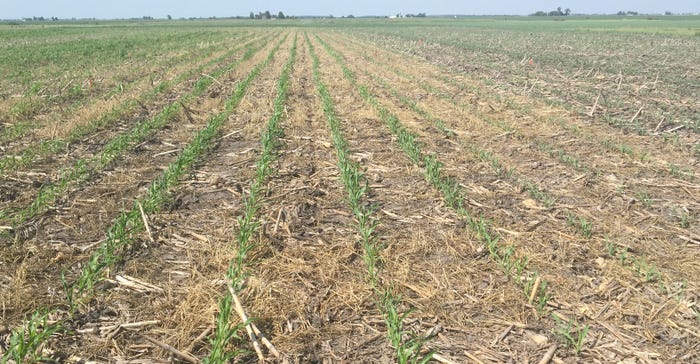March 9, 2018

By Rebecca Vittetoe
Cover crops continue to grow in popularity across Iowa. Iowa Learning Farms estimated in its 2017 annual report that the total number of cover crop acres in Iowa — and not just those planted with cost-share funds — more than doubled from 2013 to 2017, going from 300,000 to 760,000 acres.
This growing interest in cover crops can be attributed to the benefits cover crops are known to provide, including helping to improve water quality, reducing soil erosion, building soil organic matter and providing extra forage for livestock producers.
So why isn’t everyone planting cover crops? One reason may be due to the potential yield drag in corn, particularly with corn planted into a cereal rye cover crop. Factors like reduced corn stands, cooler soil temperatures, slower emergence and allelopathy have been proposed to explain why yield penalties occur in corn planted after a cereal rye cover.
Are corn seedling diseases more of a problem?
However, Alison Robertson, ISU Extension corn plant pathologist, and colleagues proposed that cover crops, particularly cereal rye, might increase the risk for seedling diseases in corn. This could result in lower plant populations or reduced plant vigor, and ultimately lower corn yields at the end of the season.
The thinking behind this was that since both corn and cereal rye are grasses, they could be susceptible to the same pathogens. Consequently, the cereal rye could serve as a “green bridge” by maintaining or increasing the population of seedling disease pathogens during the normally fallow period that occurs over winter.
As cereal rye plants die in the spring following termination, the dying rye roots release pathogens into the soil. This results in an increased pathogen population in the soil. If there is no host present, that pathogen population will decline. However, if corn is planted too soon after the rye is terminated, it’s like planting corn into a hotbed of pathogens just waiting to infect a host plant.
Cereal rye can host disease pathogens
To determine if corn seedling diseases could be partially responsible for causing lower corn yields in corn following a cereal rye cover crop, the first step involved checking to see if cereal rye could host corn seedling disease pathogens. The results of the study showed that indeed cereal rye does. It was found that cereal rye is capable of hosting corn seedling disease pathogens, including fusarium and pythium.
Knowing that rye can serve as a host to corn seedling disease pathogens, Robertson and colleagues wanted to determine if rye was serving as a green bridge. If it was, then when was the most ideal time to terminate a rye cover crop and reduce the risk for corn seedling diseases?
To determine what that ideal time was, Robertson’s lab evaluated different rye cover termination and corn planting intervals in 2014 and 2015. Treatments evaluated included a no rye check, rye terminated at 25, 17, eight and three days before planting corn, and rye terminated two days after planting corn. Data collected included final stand counts for corn, rot root incidence and yield.
Study’s results
Results from the study showed final plant stands decreased as the interval between termination and planting decreased. Rot root incidence also increased significantly with a shorter interval between rye cover crop termination and corn planting.
Further testing in the lab showed that pythium was more prevalent on corn following rye, while fusarium was present whether or not rye was used.
Corn yields in 2015 decreased with a shorter interval between rye cover crop termination and corn planting, suggesting that seedling disease may be, in part, responsible for yield drag in some years.
Based on these results, ISU’s recommendation is to wait 10 to 14 days between when you terminate a rye cover crop and plant corn to reduce the risk of corn seedling disease. In addition to following the recommended 10- to 14-day termination window, there are other factors to consider when planting corn into a rye cover crop or rye cover crop residue. Those include checking and adjusting planter settings to ensure good seed depth placement and properly closing the seed furrow.
Vittetoe is an ISU Extension field agronomist covering south central-southeast Iowa. Contact her at [email protected].
You May Also Like




